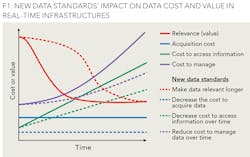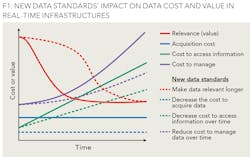Raising the standard
Gaining greater cost savings in real-time infrastructures
DAVID JOHNSON, PETROLINK, HOUSTON
ALMOST EVERY COMPANY, service provider, and software provider in the oil and gas industry today uses a real-time infrastructure to boost productivity and efficiency. A typical operator's real-time infrastructure allows users to acquire data from the field, standardize data from processes from various service providers, and then store all information for use by both the rig and corporate processes. This enables critical information to be available to the high-end analysis engineering tools that compare plans with what was designed to what is going on in real-time while drilling.
With the introduction of standards such as WITSML, companies benefitted from ensuring their data was available when they needed it, in the format they needed. The WITSML standard is an open standard for transmitting technical drilling data between disparate systems and companies in the upstream petroleum industry, allowing previously incompatible or 'closed' systems to interoperate and share data.
New cost savings await
Now imagine if companies could save pennies, dimes, and quarters in every step along the way using new processes, new techniques, and new standards that allowed them to squeeze out small cost savings on each well, ultimately compounding into millions of dollars of savings across the organization.
We are now preparing for the next version of WITSML, which will result in even greater savings for oil and gas companies. Over the past 24 months, the same industry professionals who defined, created, and built WITSML worked together to rethink and re-engineer the way the standard works. The result is the upgraded technology of WITSML 2.0 which promises reduced data traffic, faster data transfer rates and less ambiguity in the words used to communicate in this environment.
Where your real-time spend currently goes
To truly understand the cost savings offered by WITSML 2.0, consider for a moment where you currently spend money with your real-time infrastructure. To begin, there is the cost of acquiring information itself. Through what systems does the data go? Typical drilling activities involve hundreds of technical applications and solutions. Each has an actual cost as well as physical and financial impacts on infrastructure.
Next, there are the costs of keeping data alive and used. How much does it cost to standardize, maintain, and store? There are physical management costs to put the data in a corporate database and standardize it with reference names so it can be easily found and used. There is the cost of paying people to manage the database, as well as the cost to transfer it from the field to the office.
Finally, there is a tangible cost set by your network provider-the price you pay to get a byte of data from your rig to your corporate database for use. What is the network charge to transmit the data so that it can be used? Whether it's a 4G mobile card from a cell provider or satellite transmission, there's a cost to move the data. Not transferring the data isn't an option, as you would have to pay for more people to be on the rig itself.
Introducing a new standard in cost savings
Beginning with 2.0, WITSML leverages the Energistics Transport Protocol (ETP)- a new standard that results in data packets that are typically one-half to one-third the size of previous standards. If you consider the impact on simple network traffic, this new ETP standard provides a reduced transfer size that delivers cost savings. A well incurring data transfer costs of $1,000 could be reduced by as much as 50%. Consider the amount of data transferred daily from each of your wells and you can understand the savings.
Getting more value from your data, longer
Many in our industry adhere to the theory that the longer it takes for data to get from the point of acquisition to the point of consumption, the more it costs and the less relevant it is. As well, the more information you have, the harder it is to find!
So, the cost to acquire, manage, and find the right piece of data continually goes up. However, there are several methods to solve that dilemma. Most notably is to use the data sooner. If you can also reduce the cost of acquisition and management, the overall cost to find and use data is reduced, making it cost-effective to keep data longer. How do we tackle each of these impacts? (See Figure 1).
WITSML 2.0 data standards enable you to use data sooner. Because information comes in a form you can readily understand, it eliminates the need for and cost of extra computing time, extra people time and extra software costs. The captured data speaks the same language for everyone so finding data is easier as well. While this may sound fundamental, here is a test. Ask your data management department how many wells a given technology has for a specific region. Then ask how many wells are in a different technology for the same reason. The answers will never be the same.
Data standards also improve trust, which reduces the cost effectiveness curve. Engineers trying to make real-time decisions need to know that the data is not only relevant, but accurate enough to stake their reputations on it. If an engineer doesn't trust the data, he or she will spend a large amount of time and incur costs verifying the data rather than providing the correct answer to the problem.
With data standards in place, data assessment for quality and relevance becomes attainable. Without it, it's not. Before adopting standards, it was just a guess. An agreed upon assessment process alleviates the need for an engineer to spend 30-40% of his or her time verifying the data. Again, saving time and cost.
Helping engineers do the job more cost effectively
During drilling activities, unknowns always are encountered. Whether focusing on avoiding a problem or getting out of a problem, an engineer must devise a solution quickly. In both cases, there will be a financial cost in time and tools to find the answer. Data standards and standardized processes reduce the time to ideas and time to implement for the engineer. With WITSML 2.0, the engineer uses less time to build a plan, to find the plan, and compare the plan to reality. Knowing what is occurring in real-time also helps the bottom line and reduces risk.
Striking an ideal balance
"Do I minimize cost at the expense of safety or do I minimize drilling efficiency in order to maximize safety?" That is the question CEOs ask themselves every day. However, there is a balance between the two. Real-time data plays a key role in achieving this balance by helping to reduce costs while reducing risk through knowledge at the same time. It enables drillers to know how drilling activities should behave in concert with having the real-time analysis compare the plan to reality.
Bottom line? With WITSML 2.0, companies can minimize the cost of data management and technical applications every day on every well to see incremental savings multiplied by the number of active operations occurring at any given time. They can maximize resources and make better use of an engineer's time so fewer engineers are required per well. Companies can also operate as efficiently as possible to minimize time without increasing risk. Knowledge often reduces risk, so by improving knowledge and reducing costs, you save at every step along the real-time infrastructure process. As a result, companies can do more with their drilling budgets.
Using WITSML 2.0, the cost savings multiplied by all your operations can be significant. At the end of the day, with WITSML 2.0 companies can deliver more wells, more revenues, and more profits without increasing drilling budgets. Created on the theory of reducing costs, this solution makes sense to the data standards community, and, as more customers and operators adopt WITSML 2.0, they are verifying the economic improvements of the new standard.
ABOUT THE AUTHOR
David C. Johnson is the vice president of research and innovation at Petrolink. He has worked for more than 20 years as a developer, designer, database administrator, real-time advisor and product manager for companies including Landmark, Halliburton, and Kongsberg. Johnson has been active in industry data standards including the Energistics community since its inception and previously held the position of co-chair of the WITSML special interest group. Johnson graduated with a BSc in computer science from the University of Lethbridge, Alberta, Canada with specialty in databases and data management.
For more information on WITSML 2.0, visit http://www.energistics.org/


